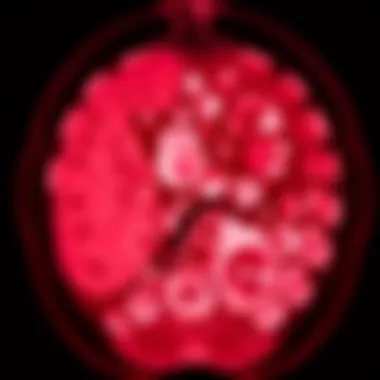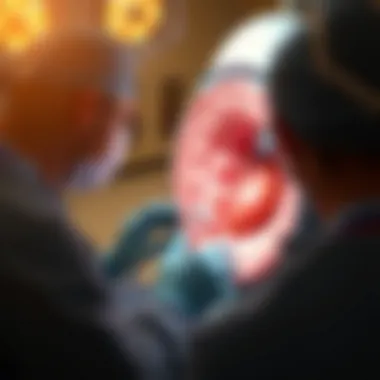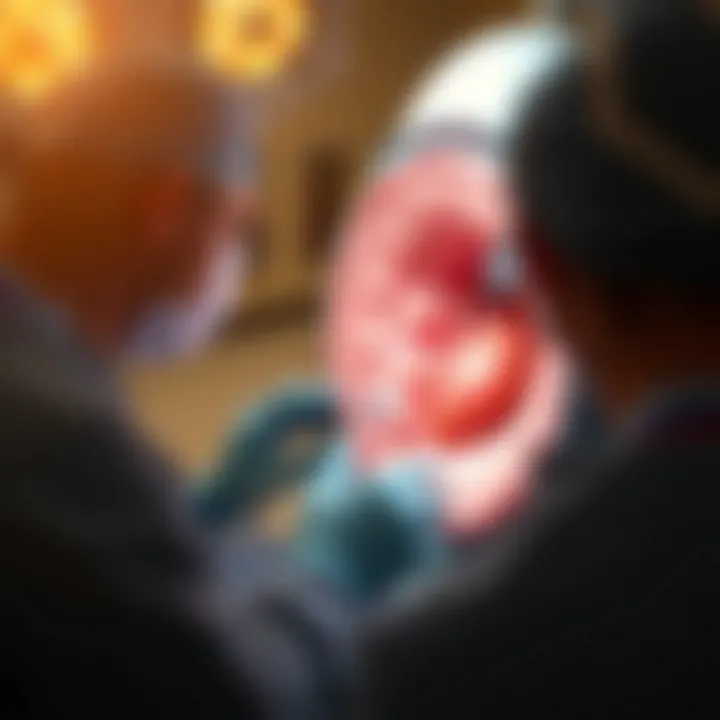Understanding Intraductal Papillary Mucinous Neoplasm of the Pancreas


Intro
In the realm of pancreatic neoplasms, the Intraductal Papillary Mucinous Neoplasm (IPMN) stands out as a unique entity deserving of detailed examination. The pancreas, an organ pivotal to digestive and endocrine processes, can be the site of various tumors, yet IPMN carries distinct implications and challenges.
Often referred to simply as IPMN, this neoplasm can be tricky, evoking a mix of intrigue and concern amongst both patients and clinicians. Based on mucinous cystic changes within the pancreatic ductal system, IPMN is notable for its potential to progress towards invasive carcinoma. Herein lies the crux of the matter: IPMN can start as a benign-seeming lesion, but without timely and accurate management, it poses a real threat.
As we unfold the layers of this complex condition in the upcoming sections, we will highlight essential aspects such as its pathology, diagnostic challenges, treatment modalities, and long-term outcomes for patients. Each of these facets plays a crucial role in understanding IPMN’s clinical significance, which makes this exploration both relevant and necessary for a variety of readers—medical professionals, students, researchers, and the informed public—all seeking clarity on this critical topic.
Our aim is to separate fact from fiction, aiding in both education and awareness. Together, we will traverse the landscape of IPMN, unraveling the intricacies from basic findings to advanced management strategies, ensuring that we illuminate the path for early detection and tailored patient care.
Preamble to Intraductal Papillary Mucinous Neoplasm
Intraductal papillary mucinous neoplasm (IPMN) of the pancreas has garnered increasing attention in recent years due to its distinctive clinical characteristics and malignant potential. Understanding this neoplasm is crucial for healthcare practitioners, researchers, and students alike, as it offers insights into pancreatic pathology and its management. The complexities involved in diagnosing and treating IPMN require a nuanced approach that underscores the importance of early detection and tailored patient management strategies.
The article dives into comprehensive details regarding IPMN, laying a spotlight on various facets, including its definition, historical significance, pathophysiology, clinical presentations, diagnostic methods, and strategies for effective management. For medical professionals who may encounter this tumor in their practice, not only is awareness pivotal, but it's also vital to grasp the subtleties encompassed within this condition.
In this exploration, we will unfold the multifaceted nature of IPMN, defining the terms and contextualizing the disease through a historical lens, thus providing a rich framework for understanding its clinical implications.
Definition and Overview
An intraductal papillary mucinous neoplasm can be characterized as a cystic lesion that arises within the ductal system of the pancreas. This neoplasm is distinct due to its production of mucin, which contributes to the cystic architecture and presents varying degrees of dysplasia. Notably, IPMNs can be classified based on the presence of an associated pancreatic ductal stricture and the degree of neoplastic transformation.
The classification of IPMNs is critical for determining their potential pathological behavior. There are generally three main types of IPMN: main duct, branch duct, and mixed type. Each type carries different implications for management and prognosis. For instance, main duct IPMNs are more likely to exhibit high-grade dysplasia or invasive cancer compared to branch duct IPMNs, which might display low-grade features.
Historical Context
The history of intraductal papillary mucinous neoplasms dates back to the early 1980s when initial descriptions began to emerge in medical literature. Dr. Masaru Tanaka and colleagues were among the first to define IPMN as a distinct tumor entity, differentiating it from other pancreatic pathologies such as mucinous cystic neoplasms and adenocarcinoma. Early recognition of IPMN paved the way for improved diagnostic criteria and a better understanding of its clinical behavior.
Over the decades, advancements in imaging technologies and histopathological insights have further solidified the characterization of IPMNs. These advancements have helped in recognizing the significance of early detection and the necessity for surgical intervention in cases with high potential for progression. Today, the landscape of research continues to expand, with ongoing studies aimed at elucidating the genetic and molecular pathways involved in IPMN development. Understanding this evolution in knowledge equips practitioners with the context necessary for patient discussions as well as management decisions.
Having a firm grasp of the definitions, classifications, and historical developments surrounding IPMN creates a solid foundation for further exploration of its pathophysiology and clinical repercussions.
Epidemiology and Risk Factors
Understanding the epidemiology and risk factors associated with intraductal papillary mucinous neoplasm (IPMN) is crucial for identifying at-risk populations and tailoring surveillance strategies. The significance of this topic in the context of IPMN cannot be overstated. Given that early detection can substantially affect treatment outcomes, comprehending these factors allows healthcare providers to optimize patient management more effectively.
Prevalence Rates
The prevalence of IPMN varies depending upon demographic factors. Statistically, the disorder is observed more frequently in older adults, particularly those aged above 60, with men being diagnosed more often than women. Research indicates that in populations undergoing imaging for other medical reasons, IPMNs can be identified in approximately 2% to 14% of cases, underscoring how often these lesions may go unnoticed until symptomatic.
Moreover, a larger problem arises from the fact that many patients may not exhibit symptoms until the disease progresses or complicates into a more severe condition, such as pancreatic cancer. This symptom overlap emphasizes the need for regular screening and awareness among those in higher-risk groups.
"IPMNs can be a proverbial ticking time bomb, often asymptomatic yet capable of evolving if left unchecked."
Genetic and Environmental Influences
The risk factors for developing IPMN encompass both genetic and environmental elements. Genetically, familial syndromes such as Peutz-Jeghers syndrome and familial pancreatitis significantly heighten the risk. These hereditary factors may contribute to a predisposition not just to IPMN, but also to its progression towards malignancy.
On the other hand, environmental influences like lifestyle choices—smoking, dietary patterns, and chronic pancreatic conditions—also play a pivotal role in the incidence of IPMN. The correlation between tobacco use and an increased likelihood of developing pancreatic abnormalities has been well-documented. Additionally, a diet high in red meat and low in fruits and vegetables has been suggested as a contributory factor.
For further reading, visit:
Pathophysiology of IPMN
Understanding the pathophysiology of Intraductal Papillary Mucinous Neoplasm (IPMN) is crucial for grasping how these tumors behave, progress, and affect patients' lives. At the core, IPMN represents a disturbance within the pancreatic ductal system, characterized by the proliferation of mucinous epithelial cells. This section aims to illuminate the intricacies of this phenomenon, highlighting the mechanisms that drive tumorigenesis and the implications for patient management.
Mucins and their Role in Tumorigenesis
Mucins are large glycoproteins produced by epithelial tissues, and they play a significant role in the pathophysiology of IPMN. They are not just bystanders; rather, they actively influence tumor biology. In the context of IPMN, the overproduction of mucins can lead to obstruction within the pancreatic duct, creating an environment conducive to tumor growth. This obstruction can trigger a cascade of biological responses, including inflammation and subsequent cellular changes that may enhance the likelihood of malignant transformation.
Key characteristic: The mucin composition in IPMNs often varies, reflecting the complexity of these tumors. MUC1, MUC2, and MUC5AC are some of the most commonly studied types. The profiles of these mucins can provide vital clues about the tumor’s behavior and prognosis. For instance, a predominance of certain mucin types may correlate with increased risk of malignancy, allowing for better stratification of patients based on their individual risk profiles.


"The type and quantity of mucins secreted can serve as potential biomarkers, providing insights into tumor dynamics and guiding therapeutic decisions."
Histological Classification
Histological classification of IPMN is foundational to understanding its clinical significance and management. This classification system categorizes IPMNs based on their architectural patterns and cytological characteristics, which plays a vital role in determining the prognosis and appropriate treatment plans.
Main types of IPMN
The main types of IPMN—main duct type, branch duct type, and mixed type—each exhibit unique histopathological features that aid in diagnosis and management strategies.
- Main duct IPMN is directly connected to the main pancreatic duct and is often more likely to progress to invasive cancer. It comprises a significant characteristic of high-grade dysplasia and can become quite aggressive if not identified early. The critical feature of this type is its direct duct involvement, which can lead to obstructive symptoms early in the clinical course.
- Branch duct IPMN, on the other hand, typically has a better prognosis. These tumors are often smaller and may be asymptomatic for longer periods. A unique feature of this type is its potential for cystic formation, which can sometimes complicate diagnosis and careful monitoring protocols.
- Mixed type IPMN, as the term suggests, exhibits a combination of features from both main and branch types, thereby raising a challenge in both management decisions and patient counseling.
Understanding these types allows clinicians to tailor surveillance strategies and intervention protocols based on their distinct risk profiles.
Pathological features
The pathological features of IPMN—ranging from cytological atypia to stromal invasion—provide additional layers of insight into tumor behavior and potential outcomes. Key characteristics include the architecture of glandular formations and the degree of cellular atypia. In particular, the presence of high-grade dysplasia can serve as a red flag indicating a higher risk for progression to invasive cancer.
A unique aspect of pathological examination involves distinguishing between low-grade and high-grade dysplasia. Low-grade IPMNs often exhibit a more indolent course, while high-grade lesions pose a significant risk for malignancy and thus require vigilant follow-up or surgical intervention.
In summary, the pathophysiology of IPMN is complex yet pivotal in shaping clinical practice. By understanding the roles of mucins and adhering to detailed histological classifications, healthcare professionals can enhance patient outcomes through timely intervention and personalized care plans.
Clinical Presentation
Understanding the clinical presentation of Intraductal Papillary Mucinous Neoplasm (IPMN) is crucial for timely diagnosis and management. The subtlety of its symptoms often poses diagnostic challenges, so recognizing the signs early can significantly influence treatment outcomes. Health practitioners need to grasp the clinical nuances associated with IPMN to develop informed management strategies.
Symptoms and Signs
Identifying the symptoms of IPMN can sometimes feel like searching for a needle in a haystack. Patients may present with a range of non-specific symptoms, which complicate the diagnostic picture. Common symptoms include:
- Abdominal pain or discomfort.
- Nausea and vomiting, particularly after meals.
- Unexplained weight loss, often noticed over a short period.
- Pancreatitis episodes, marked by severe abdominal pain that radiates to the back.
- Changes in bowel habits, such as diarrhea, possibly a sign of malabsorption.
Notably, many patients remain asymptomatic until the neoplasm progresses. This characteristic emphasizes the importance of vigilant screening in individuals at higher risk, like those with a family history of pancreatic cancer or genetic predispositions such as mutations in the BRCA2 gene.
Moreover, some patients might experience digestive manifestations, such as steatorrhea, hinting at pancreatic insufficiency due to duct obstruction. Each symptom carries weight, but their vague nature necessitates a thorough clinical evaluation and correlating imaging studies to reach a definitive diagnosis.
"Early symptoms are often mistaken for benign digestive issues, underscoring the importance of recognizing potential red flags for pancreatic disorders."
Differential Diagnoses
When it comes to diagnosing IPMN, distinguishing it from other pancreatic conditions is imperative. Several disorders may mimic its clinical presentation, creating a veritable conundrum for clinicians. The key differential diagnoses include:
- Pancreatic Adenocarcinoma: This aggressive malignancy often shares symptoms with IPMN but usually presents later in its course with more pronounced jaundice and weight loss.
- Chronic Pancreatitis: Inflammation of the pancreas can generate symptoms similar to IPMN. Careful evaluation of imaging studies can reveal ductal changes associated with chronic pancreatitis versus mucinous dilations seen in IPMN.
- Serous Cystadenoma: Unlike IPMN, this tumor is typically benign and presents as cystic lesions in the pancreas, requiring specific imaging characteristics for accurate identification.
- Other Cystic Lesions: Various cystic conditions of the pancreas, like pseudocysts from prior pancreatitis, can simulate the appearance of an IPMN on imaging.
A thorough understanding of these conditions fosters a more accurate diagnosis, helping healthcare professionals avoid missteps in treatment approaches. Clinicians often rely on advanced imaging modalities like CT and MRI to clarify these grey areas, and a biopsy may further aid in diagnostic certainty where ambiguities persist.
Diagnostic Approaches
The diagnostic approaches for Intraductal Papillary Mucinous Neoplasm (IPMN) are crucial elements in understanding and effectively managing this unique pancreatic condition. Given the nuanced nature of IPMN, accurate diagnosis hinges on a combination of imaging techniques and biopsy methods. This ensures that any potential neoplasms are detected before they progress, enabling timely intervention.
Imaging Techniques
Imaging techniques are the backbone of diagnosing IPMN. They help visualize the structure and form of the pancreatic duct and surrounding tissues, elucidating any abnormalities that may suggest the presence of IPMN.
CT Scans
CT scans are a highly valued tool in the evaluation of suspected pancreatic lesions. They provide remarkably clear images and are often the first choice when assessing pancreatic masses. One key characteristic of CT scans is their ability to generate cross-sectional images of the pancreas, which helps clinicians view potential cystic lesions in relation to the pancreatic duct. This makes CT particularly important for differentiating IPMN from other pancreatic tumors.
Additionally, CT scans can be enhanced with contrast agents, improving the visibility of fine details. The rapid acquisition of images is beneficial, reducing the time patients spend in the diagnostic process. However, there are downsides; for example, radiation exposure is a concern with repeated scans. This means while CT scans are effective, careful consideration is required regarding how often they are used.
MRIs
MRIs are another pivotal imaging technique employed in the diagnosis of IPMN. What sets MRIs apart is their non-invasive nature and the lack of radiation exposure, making them a safer choice for certain patients. MRIs utilize magnetic fields and radio waves to produce detailed images of soft tissues. They are particularly adept at distinguishing between mucinous and non-mucinous cysts, thus contributing to a more accurate diagnosis.
A unique feature of MRIs is the use of specific imaging sequences, particularly diffusion-weighted imaging (DWI), which can indicate cellularity in lesions and possibly predict the biological behavior of the neoplasm. However, the longer duration of MRI exams compared to CTs can be a drawback, as some patients may struggle to stay still for extended periods.


Endoscopic Ultrasound
Endoscopic ultrasound (EUS) combines endoscopy and ultrasound, allowing for a detailed view of the pancreas from inside the gastrointestinal tract. One of its significant advantages is the ability to retrieve fine-needle aspirations (FNA) of cystic lesions, which can be crucial for confirming the diagnosis of IPMN.
EUS can detect smaller lesions that traditional imaging techniques might miss, thus providing a very sensitive means for identifying early-stage neoplasms. This sensitivity makes EUS especially valuable in high-risk populations. However, the need for sedation and the skill required for the procedure can serve as barriers to its widespread use.
Biopsy Techniques
Alongside imaging modalities, biopsy techniques play a fundamental role in diagnosing IPMN. They provide definitive evidence of the nature of the lesions present within the pancreatic ductal system. These methods can often guide physicians in determining the most appropriate management strategies.
Biopsies can be performed through EUS, where fine-needle aspiration allows for obtaining cells directly from the lesion. Alternatively, surgical biopsies can be considered if the imaging results are equivocal and clinical suspicion remains high.
In summary, the diagnostic approaches for IPMN are multifaceted, integrating various imaging and biopsy techniques to form a comprehensive picture of the patient’s condition. Each method has its strengths and limitations, and typically they are employed in conjunction to achieve the best possible results for patient outcomes.
Management Strategies
Managing Intraductal Papillary Mucinous Neoplasm (IPMN) of the pancreas is a multifaceted endeavor, driven by the tumor's potential for progression and the various patient-specific factors at play. The strategy encompasses both surgical interventions and non-surgical approaches, emphasizing the necessity of individualized treatment plans.
Surgical Interventions
Surgical interventions stand as a cornerstone of management for IPMN, particularly when there are signs of malignancy or significant risk factors identified. Surgery is generally considered the most definitive option for patients who are fit enough for the procedure. The crux of surgical approach lies in adequately assessing the nature of the neoplasm as well as the patient's overall health.
Indications for Surgery
When it comes to indications for surgery, several factors dictate the decision to proceed. Higher-risk lesions such as main duct IPMNs or those showing rapid growth are prime candidates for surgical intervention. A key characteristic of this pathway is the emphasis on early surgical consultation.
- Why Indications Matter: Understanding the specific indications helps in triaging patients and determining their prognosis.
- Unique Benefit: Removing the neoplasm at an early stage can significantly reduce the risk of progression to invasive cancer.
However, not all cases necessitate immediate surgical action; some patients may benefit from careful monitoring instead, allowing for a more tailored approach that takes into account tumor behavior as well as the overall health condition of the patient.
Techniques
Diverse surgical techniques are applied depending on the tumor's characteristics and its location. Common methods include Whipple procedure, distal pancreatectomy, or total pancreatectomy. Their selection often hinges on the extent of the disease.
- Key Characteristic: The adaptability of surgical techniques permits a customized approach, addressing the unique needs of each patient.
- Points to Consider: Each technique has its own set of advantages and disadvantages, such as recovery time, potential complications, and the degree of surgical invasiveness.
Non-Surgical Approaches
While surgery is often the go-to solution, non-surgical approaches come into play significantly for certain patients, particularly those not suitable for surgery or whose IPMN presents no immediate threat.
Surveillance Protocols
Surveillance protocols are crucial for managing patients with low-risk IPMN. Regular imaging studies and clinical assessments are vital in tracking any changes that might suggest malignant transformation.
- Importance: The benefit of close monitoring lies in the ability to detect progressions at an early stage, which could warrant an immediate change in management strategy.
- Features and Benefits: Unique protocols may involve varying intervals for imaging based on the patient's age, history, and the specific characteristics of their IPMN.
However, these protocols require rigorous adherence from patients to ensure the best outcomes. Otherwise, the risk lies in delays in intervention, should the situation change.
Pharmacotherapy
Pharmacotherapy has also gained attention in the management of IPMN, especially in the context of adjunct treatment. Researchers are exploring the role of medication to either shrink existing neoplasms or to help manage symptoms.
- Significance: A common trope in medical circles, "better living through chemistry," underscores the potential pharmacotherapy offers in supporting patients before or after surgery.
- Advantages and Disadvantages: The unique appeal lies in its non-invasive nature, yet the effectiveness and required duration of therapy can be a concern, often requiring frequent adjustments to optimize treatment.
In summary, the management of IPMN demands a well-rounded approach, integrating both surgical and non-surgical strategies tailored to individual patient profiles. The goal remains to optimize clinical outcomes while minimizing risks, requiring collaboration across various specialties.
"Adapting management strategies to align with the evolving understanding of IPMN can markedly enhance patient care and outcomes."
For more detailed insights, consider exploring resources such as NIH or National Cancer Institute.
Additionally, information from Mayo Clinic can provide valuable context on management strategies.
This is not a one-size-fits-all journey, but a comprehensive set of strategies that prioritize patient safety and personalized care.


Postoperative Care and Complications
Postoperative care and complications play a significant role in the management of patients recovering from surgery for intraductal papillary mucinous neoplasm (IPMN). This stage can make or break the outcomes, especially considering the nature of the operation itself and the complexities associated with IPMN.
Overall, postoperative care aims to optimize recovery, reduce the risk of complications, and ensure proper monitoring of the patient. It encompasses a variety of areas, such as pain management, fluid and electrolyte balance, and regular assessments for signs of infection or other complications.
Expected Outcomes
Patients who have had surgery to remove IPMN can anticipate varying outcomes based on multiple factors, including the tumor's pathology and the completeness of surgical resection. Generally, those who undergo successful surgery report a good quality of life and a significant reduction in symptoms associated with the disease. Additionally, any malignancy detection during surgery could lead to a more aggressive course of treatment if necessary.
However, it is crucial to highlight that recovery is not straightforward. Patients often experience discomfort or complications post-surgery, which can interfere with the healing process. For some, the initial postoperative period can be rife with uncertainty as they await pathology results and recovery progress. Regular follow-ups and communication with healthcare providers are vital to navigating this phase effectively.
Potential Complications
Despite careful planning and execution of surgical interventions, complications can and do occur. Addressing these complications early is paramount in preventing more serious ramifications.
Recurrence Rates
Recurrence rates refer to the likelihood that the IPMN will return after surgical resection. This aspect is especially pertinent as clinicians and patients alike try to gauge long-term prognosis. A distinguishing feature of IPMN is its potential for multifocality, meaning that new lesions can develop even after one has been surgically removed. Studies show that the recurrence rate can hover around 20% to 30% within five years, which is rather significant. This aspect underscores the importance of routine follow-up scans to detect any new developments promptly.
Highlighting recurrence rates is beneficial, as it emphasizes the necessity for ongoing vigilance in monitoring health after treatment. Not only might this lead to an increased quality of life through early detection, but it also fosters a collaborative approach between patient and doctor in navigating the complex landscape of cancer care.
Long-term Monitoring
Given the risk of recurrence, long-term monitoring becomes an integral part of postoperative care. Regular follow-ups typically involve imaging assessments like MRI or CT scans, which are critical in identifying any unusual developments. This monitoring allows for timely intervention should any new strains of the neoplasm arise.
A key characteristic of long-term monitoring is its role in fostering patient confidence. Knowing that there will be a structured follow-up plan in place can alleviate some of the anxiety that patients may feel after surgery. However, it is a double-edged sword; while long-term monitoring can lead to prompt interventions, it can also create anxiety around tumor markers and imaging findings.
Unique aspects of long-term monitoring include the ability to tailor follow-up schedules based on the individual's health status and prior surgical outcomes. This personalized approach enhances the overall effectiveness of postoperative care but requires clear communication between the healthcare team and the patient, ensuring that the patient remains engaged and informed.
In summary, while undergoing surgery for IPMN, understanding potential complications like recurrence rates and adhering to a firm long-term monitoring plan can greatly influence the patient's quality of life and long-term prognosis.
Current Research and Future Directions
Intraductal papillary mucinous neoplasm (IPMN) represents an evolving field of research within pancreatic oncology. Its unique characteristics are prompting an array of studies that tackle everything from basic science to clinical applications, making it crucial for healthcare professionals and researchers alike. The ongoing investigation surrounding IPMN not only enhances our understanding of its biologic behavior but also opens avenues for improved diagnosis, treatment, and patient management. Moreover, this sphere of research augments the overall landscape of pancreatic diseases, ensuring that advancements are made in the detection and management of related conditions.
Ongoing Clinical Trials
There are several clinical trials currently exploring effective treatments and strategies for IPMN. These trials often target therapies that have shown promise in similar neoplastic conditions, but they also seek to tailor these approaches specifically for IPMN due to its distinct characteristics. Here are a few notable trials:
- The role of biomarkers: Some studies are investigating the predictive power of serum and tissue biomarkers in diagnosing IPMN and determining the likelihood of malignant transformation. Monitoring these markers could lead to earlier interventions and improved patient outcomes.
- Pilot studies on pharmacologic therapies: A number of trials are assessing the efficacy of targeted agents such as gemcitabine and nab-paclitaxel in patients with IPMN, particularly those with high-risk features, to prevent progression to invasive cancer.
- Surveillance strategies: Trials are also examining which surveillance protocols best identify patients at heightened risk of progression. These protocols look into optimal imaging techniques in conjunction with clinical evaluations to develop personalized follow-up strategies.
A key focus of these trials is understanding which patients benefit most from which approaches, often illustrating the need for a multifaceted treatment paradigm. Early results from these ongoing trials may shift the clinical landscape, enabling better risk stratification and tailored management.
Innovative Therapeutic Approaches
As the research surrounding IPMN continues to broaden, some innovative therapeutic approaches are emerging. Noteworthy advancements include:
- Minimally invasive techniques: Surgical options are evolving with advances in laparoscopic and robotic-assisted techniques, facilitating less traumatic interventions. These methods are designed to reduce recovery time while preserving pancreatic function.
- Molecularly targeted therapies: Research is currently ongoing about therapies that specifically target genetic mutations commonly found in IPMN. For instance, trials exploring the use of drugs targeting the KRAS mutation could present new paths for treatment, granting a more personalized approach to each patient's care.
- Combination therapies: Combining surgical strategies with adjuvant therapies may yield improved outcomes. Such strategies might involve integrating chemotherapy or immunotherapy in the postoperative phase, aiming at the prevention of recurrence and harboring an opportunity for long-term survival.
"The exploration of novel therapeutic strategies is pivotal in transforming the prognosis of patients with IPMN. By utilizing both surgical and medical innovations, we can provide comprehensive treatment that meets the unique needs of each patient."
The ongoing research and the innovative approaches underline an essential understanding: managing IPMN requires a multipronged strategy, blending existing knowledge with pioneering practices. As new findings continue to emerge, they will play a crucial role in refining the standards of care and optimizing outcomes for patients grappling with this complex neoplasm.
Finale
In summarizing the complexities surrounding intraductal papillary mucinous neoplasm, it becomes evident that this condition holds significant relevance in the realm of pancreatic disorders. The insights gleaned from thorough analysis pave the way for improved clinical outcomes, patient education, and strategic management.
Summary of Findings
We’ve seen that IPMN is no mere footnote in the literature of pancreatic tumors. The data reveals that early detection plays a pivotal role in patient prognosis. Multidisciplinary approaches have shown that nuanced understandings of IPMN's behavior are crucial. Highlighting key findings:
- Types: Various subtypes of IPMN manifest distinctly. These range from low-risk forms to those potentially leading toward invasive cancer.
- Symptoms: Many patients may remain asymptomatic until further progression, emphasizing the need for vigilant monitoring in at-risk individuals.
- Diagnostic Techniques: The role of advanced imaging and effective biopsy methods cannot be underestimated. Techniques like MRI and endoscopic ultrasound have been game changers in accurate diagnosis.
"The pathophysiology of IPMN intertwines factors such as mucin production and cellular behavior, painting a more detailed picture of its risk stratification and management strategies."
Implications for Clinical Practice
Understanding the nature of IPMN equips clinicians with essential tools for patient care. The implications stretch far and wide:
- Personalized Treatment Plans: By recognizing the unique characteristics of each case, tailored management strategies can be developed, improving patient quality of life.
- Regular Surveillance: For those identified with IPMN, ongoing monitoring becomes imperative. This continual vigilance can facilitate early intervention and timely decision-making.
- Patient Education: Empowering patients through knowledge and understanding of their condition fosters better engagement in their treatment journey.







